posted on April 25, 2010 by Merry-Jennifer
There are some recipes that must always appear at holiday dinners simply because of tradition. Somewhere along the line, my husband’s grandmother’s cornbread dressing showed up at their holiday dinner table, and it was there to stay.
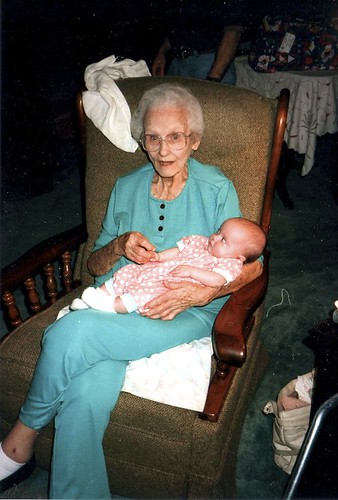
Sam’s grandmother, always known to the entire family as Grandma, was the essential home cook. Grandma prepared one big meal each and every day, and this meal was the dinner meal. And in true Southern tradition, dinner was served around noon. The evening meal, supper, was much lighter fare, typically without much fuss. Supper usually consisted of leftovers, soup, or sandwiches.
posted on April 23, 2010 by Merry-Jennifer
I have a weird habit. Some might say that I have more than just one, but I’m only going to tell you about one weird habit today.
When I’m at the gym working out on the elliptical machine (my favorite) or the stationery bike (my go-to machine if the elliptical machines are full), I read food magazines. And watch food and cooking shows. I’ve tried reading other things at the gym or watching the music video channels, an old movie, or even CNN. But nothing makes the time fly by faster while I’m huffing and puffing on that machine like a good Barefoot Contessa show or the latest issue of Food & Wine. Recently, I even caught an old PBS episode of Jacques Pepin and Julia Child making eggs. I had a fantastic workout that day and I learned a lot about cooking eggs, too.
A couple of weeks ago, I made it to the gym while the Barefoot Contessa was on, and a pasta sauce recipe caught my eye. The show featured a recipe from Joe Realmuto, the executive chef of East Hampton New York’s Nick and Toni’s, and was for the restaurant’s well-loved creamy tomato and vodka sauce. I love almost anything that Ina Garten makes, and knew that for her to feature this sauce on her show, it must be damn good.
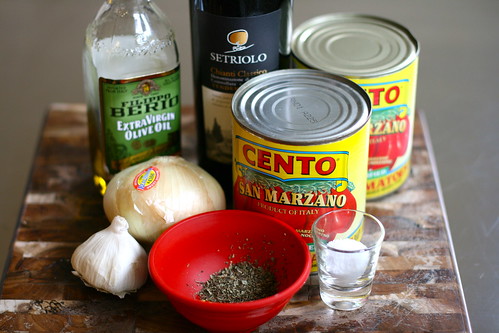
The recipe called for vodka, but since I had no vodka on hand (crazy, right?) and a pantry overflowing with wine, I used a great Chianti instead. A good rule of thumb when it comes to cooking with wine is to only use a wine that you’d be happy drinking as well. The Setriolo 2005 Chianti Classico was very flavorful, juicy and medium-bodied – great for serving with the finished dish.
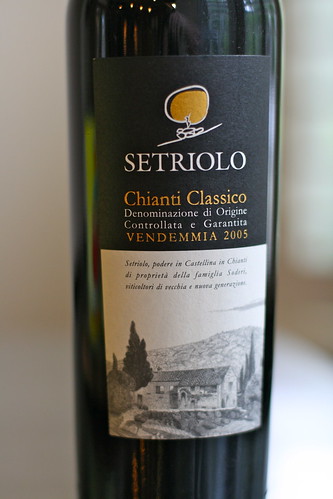
While penne pasta was the pasta of choice for Joe Realmuto’s sauce, I used gnocchi. I would imagine that any pasta that holds a creamy sauce well would work great.
I used D.O.P. certified San Marzano tomatoes, and I just can’t recommend them enough. I tend to use the Cento brand, and I can find them at my local Publix or Fresh Market.
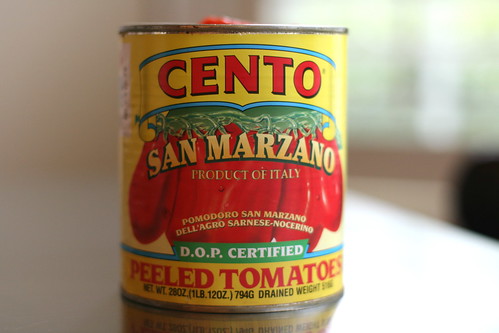
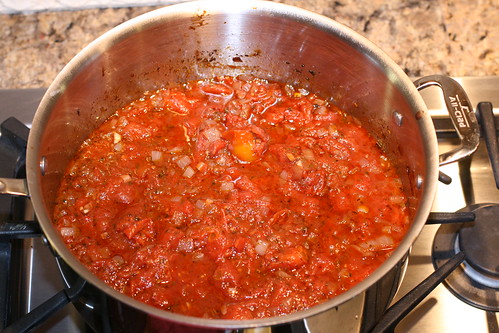
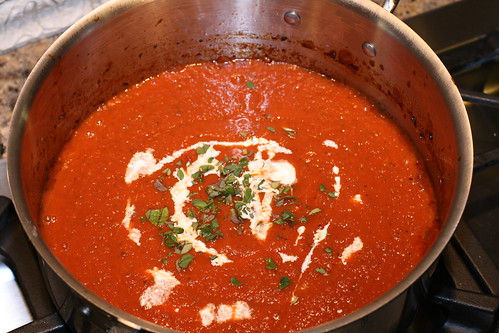
The sauce was fabulous – rich and creamy. From the the photo of the finished dish (not the best photo, but I was having an off night) you can see that I’m a real sauce person. I get carried away sometimes and drown my pasta in it. But what can I say? I just love sauce. And I loved this one.
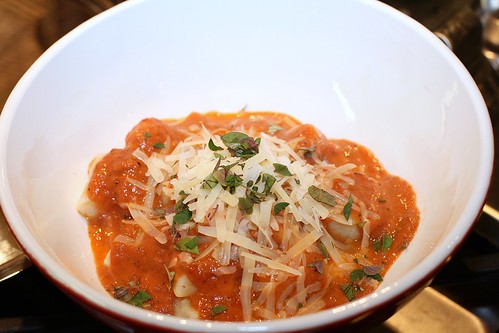
Nick and Toni's Alla Vecchia Bettola
Ingredients:
1/4 cup olive oil
1 medium Spanish onion, chopped
3 cloves of garlic, diced
1/2 teaspoon crushed red pepper flakes
1 1/2 teaspoons dried oregano
1 cup good red wine [I used a Chianti, but a Zinfandel or Cabernet Sauvignon would work.]
2 (28-ounce) cans San Marzano peeled plum tomatoes [DOP certified, such as Cento.]
Kosher salt
Freshly ground black pepper
3/4 pound penne pasta (or other pasta of your choice)
4 tablespoons fresh oregano
3/4 to 1 cup heavy cream
Grated Parmesan cheese
Directions:
Preheat oven to 375 degrees.
Heat the olive oil in a large oven proof saute pan over medium heat, add the onions and garlic, and cook for about 5 minutes until translucent. Add the red pepper flakes and dried oregano and cook for 1 minute more. Add the wine and continue cooking until the mixture is reduced by half.
Meanwhile, drain the tomatoes through a sieve and crush them into the pan with your hands. Add 2 teaspoons salt and a pinch of black pepper. Cover the pan with a tight fitting lid and place it in the oven for 1 1/2 hours. Remove the pan from the oven and let cook for 15 minutes.
Meanwhile, bring a large pot of salted water to a boil and cook the pasta al dente. Drain and set aside.
Place the tomato mixture in a blender and puree in batches until the sauce is a smooth consistency. Return it to the pan.
Reheat the sauce, add 2 tablespoons of fresh oregano and enough heavy cream to make the sauce a creamy consistency. Add salt and pepper to taste, and simmer for 10 minutes. Toss the pasta into the sauce and cook for 2 minutes more. Stir in 1/2 cup Parmesan. Serve with an additional sprinkle of Parmesan and some fresh oregano on each plate.
(Just slightly adapted from Joe Realmuto's recipe featured on the Barefoot Contessa on Food Network, this episode.
posted on April 20, 2010 by Merry-Jennifer
While on the hunt for an appetizer recipe to bring to a wine and cheese party we were invited to recently, I stumbled across this post by Deb of Smitten Kitchen. Her site is an amazing wealth of recipes, great writing, and food photography. And, as often happens, one of the dishes featured in her post caught my eye.
I am a serious novice when it comes to French cuisine, but attempting to make some classic French dishes is on my running list of things I want to accomplish in the kitchen. I’m not sure that gougères are a classic French appetizer, but they are indeed French, and it took me several tries to pronounce it correctly, so I think they count.
The basis of the dish is the choux paste, a very sticky pastry dough. I turned to the food science expert, Harold McGee, and his book On Food and Cooking: The Science and Lore of the Kitchen , for some background information on choux paste and gougères. This is what Harold says:
, for some background information on choux paste and gougères. This is what Harold says:
Choux is the French word for “cabbage,” and choux pastry forms little irregular cabbage-like balls that are hollow inside like popovers…It provides the classic container for cream fillings in such pastries as cream puffs (profiteroles) and éclairs, and also makes such savory bites as cheese-flavored gougères and deep fried beignets, whose lightness inspired the name pets de nonne, “nun’s farts.”
Choux paste was apparently invented in late medieval times, and it’s prepared in a very distinctive way. It’s a cross between a batter and a dough, and is cooked twice: once to prepare the paste itself, and once to transform the paste into hollow puffs.
So, wow. I learned something. I just love that book. It’s such a great resource in the kitchen. Plus, who knew I’d learn about nun’s farts?

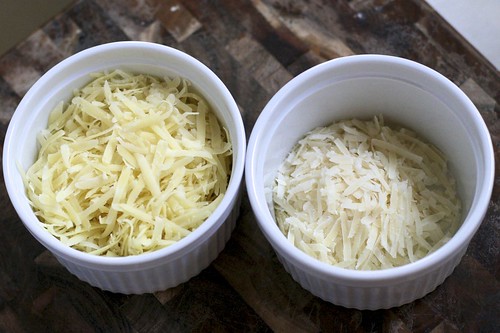
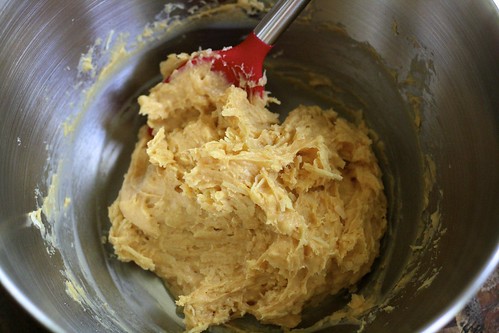
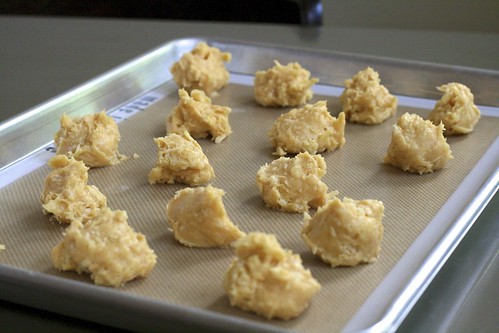
The recipe was very easy to follow and quite quick, too. I baked one batch on parchment paper and the other on a Silpat baking mat. The ones baked on the parchment puffed up more and looked more golden brown on top. The others came out puffy but then fell a bit. Both tasted delicious – savory, filled with the rich taste of the Gruyère, the sweet smokiness of the Spanish paprika, and saltiness from the sprinkling of fleur de sel on top of each puff.
baking mat. The ones baked on the parchment puffed up more and looked more golden brown on top. The others came out puffy but then fell a bit. Both tasted delicious – savory, filled with the rich taste of the Gruyère, the sweet smokiness of the Spanish paprika, and saltiness from the sprinkling of fleur de sel on top of each puff.
Gougères have been added to my make-again list. It was such a simple, tasty appetizer to make – if you ignore the hassle of cleaning the sticky choux paste out of the food processor, that is.
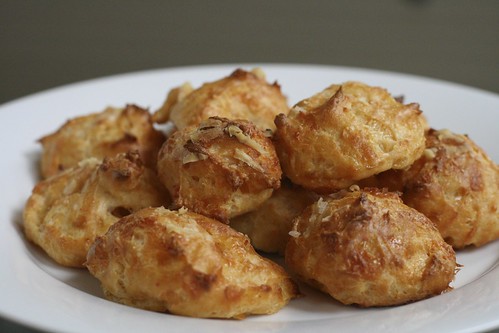

Ingredients:
1 cup milk
4 tablespoons unsalted butter
1/4 teaspoon salt
Dash cayenne pepper
1 cup all-purpose flour
3 large eggs
1/2 teaspoon paprika [I used the Spanish paprika, Pimenton de la Vera Dulce.]
1/2 cup grated Parmesan cheese
1 1/2 cups grated Gruyère
Fleur de sel or other coarse salt to sprinkle on top
Directions:
Bring the milk, butter, salt, and cayenne to a boil in a saucepan. Remove from heat, add the flour all at once, and mix vigorously with a wooden spatula until the mixture forms a ball. Return the pan to the heat and cook over medium heat, stirring occasionally, for about 1 minute to dry the mixture a bit. Transfer to the bowl of a food processor, let cool for 5 minutes, then process for about 5 seconds.
Add the eggs and paprika to the processor bowl, and process for 10-15 seconds, until well-mixed. Transfer the choux paste to a mixing bowl and let cool for 10 minutes.
Preheat the oven to 375 degrees. Line a cookie sheet with a reusable nonstick baking mat or parchment paper. Reserve 1 tablespoon of the grated Parmesan cheese, then add all of the remainder and all of the Gruyère to the choux paste. Stir just enough to incorporate. Using a tablespoon, scoop out a level tablespoon of the gougère dough, and push it off the spoon onto the cooking mat. Continue making individual gougères, spacing them about 2-inches apart. Sprinkle a few grains of the coarse salt (or Fleur de sel) and a little of the reserved Parmesan cheese on each gougère.
Bake for about 30 minutes, until nicely browned and crisp. Serve lukewarm or at room temperature.








 Print
Print








